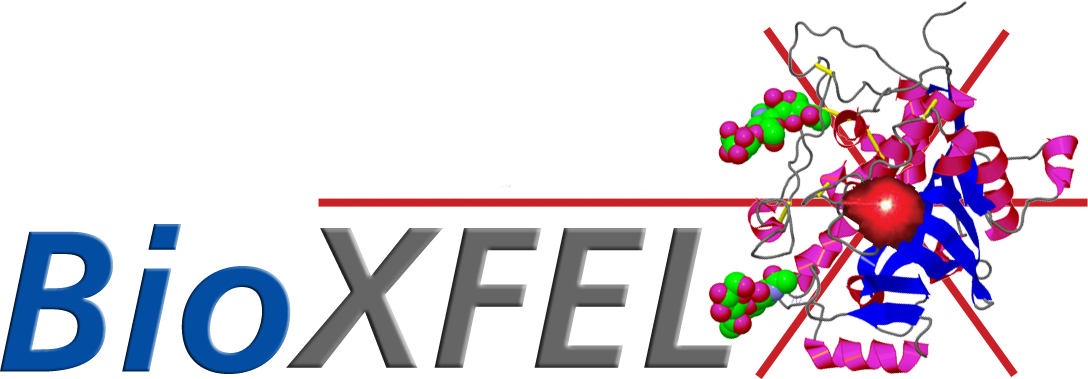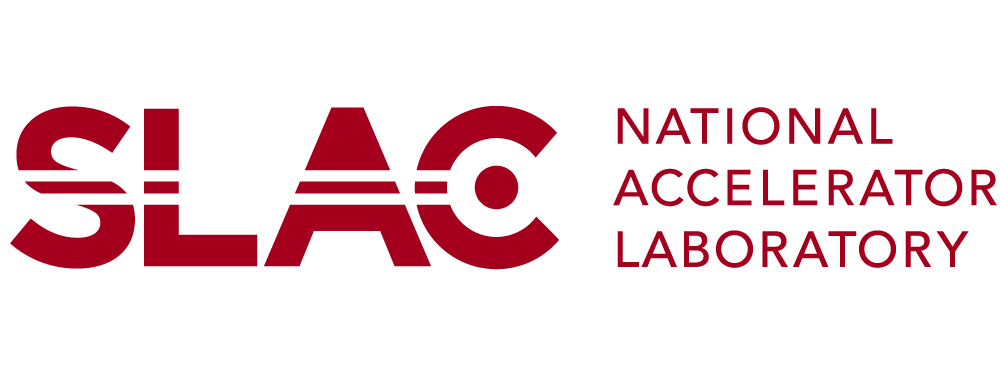| Description: |
Click here to view the workshop tutorials
2014 Data Analysis Workshop
We are pleased to announce the first Workshop on Bio-XFEL Data Analysis, organized as a collaborative effort between the NSF BioXFEL Science and Technology Center, the Physical Biosciences Division of Lawrence Berkeley National Laboratory and SLAC National Accelerator Laboratory.
Organizers
Nick Sauter (nksauter @lbl.gov)
Nadia Zatsepin (nadia.zatsepin @asu.edu)
Date and location
The 2014 Workshop on Bio-XFEL Data Analysis will be held over 2 days, August 21 - 22nd, 2014, at Lawrence Berkeley National Lab, California. Participants will be housed on site at the LBNL Guest House. The workshop will begin at 8:30 am. on the 21st and conclude by 5 p.m. on the 22nd.
Description
Serial crystallography is a rapidly growing field with a correspondingly rapidly growing user base. One of the main bottlenecks in serial crystallography is the ability to rapidly filter and analyze large datasets to arrive at accurate structure factors for structure solution and refinement. This workshop is designed as an introduction to serial crystallography analysis tools, and discussion of how to recognize and address data processing challenges and assess the data quality compared to 'normal' synchrotron crystallography.
2 day program outline (see table below)
Day 1 will consist of lecture sessions covering an introduction to serial (femtosecond) crystallography (SFX), software suites available for SFX data analysis and key issues in data processing and assessment of SFX data quality.
Day 2 will involve hands-on computer tutorials and live demonstrations covering the software presented on day 1. These computer lab sessions are limited to 30 participants. The tutorials will be run by the software developers with a team of expert users. LCLS will be providing computing facilities.
| Speaker |
Title |
Description |
| Thursday (8:30 am - 7:00 pm) |
| Nadia Zatsepin |
Introduction to workshop and to serial crystallography |
|
| John Spence |
How XFEL MX differs from MX and why we do it |
|
| Paul Adams |
BioXFEL in the greater context of crystallography |
|
| Anton Barty |
Cheetah: Data Reduction and Pre-Processing |
Photons, detectors and data streams: how to get at the data and what it records. Data reduction and pre-processing: how it works and how to optimize it. |
| Karol Nass |
CASS: Rapid Data Quality Feedback and Online Monitoring using CASS |
Description of the layout of CASS software suite and its functionality on the LCLS online and offline data streams. Real time monitoring of the SFX experiment: hit rate, resolution, pixel saturation, 2D powder pattern. Rapid offline processing of the raw LCLS data: crystal hit finding, extraction of images into HDF5 or cbf formats, pulse characterisitcs, fluorescence spectra, other data specific to an experiment. |
| Tom White |
Indexing and Integration using CrystFEL |
CrystFEL is a suite of programs that deal with viewing, indexing, integrating and merging serial crystallography data, evaluating its quality and simulating patterns. At the core of CrystFEL is an automated, high throughput processing pipeline which indexes and integrates each diffraction pattern in a serial crystallography data set. Merging the results yields diffraction data which can be imported into standard crystallographic processing packages for further analysis. |
| Nick Sauter |
How good are my data? |
A design goal of the data reduction package cctbx.xfel is to discover and apply the numerous systematic corrections necessary to correctly model XFEL diffraction images. Numerous challenges must be addressed to interpret serial femtosecond diffraction, including an inaccurate knowledge of the detector's micron-scale metrology, diffraction patterns with multiple lattices and different resolution cutoffs, and the difficulties in modeling crystal orientation from still shots. The ultimate endpoint is to be able to obtain the most accurate structure factors possible by scaling and merging a limited number of images. |
| Aaron Brewster |
Practical considerations during processing of serial crystallographic XFEL data. |
Fundamental differences exist between processing rotational data collected at a synchrotron source and data collected during a serial crystallographic XFEL experiment. Practical techniques will be described to enable the user to get the most out of their data using the cctbx.xfel package, from properly tuning parameters used during spot finding to common pitfalls encountered while indexing and merging. Specific attention will be paid to real use cases from users in the past, and how problems with their data were addressed. |
| Johan Hattne |
From cctbx to cctbx.xfel and beyond |
Algorithms to process X-ray diffraction images into accurate atomic models of macromolecules have undergone steady refinement over the past decades. As methods by which crystallographic diffraction patters are obtained are further developed, these techniques continue to provide a solid base from which new processing programs can be bootstrapped. The Computational Crystallography Toolbox (cctbx) collects a wealth of such routines for data analysis and provided the functionality to get cctbx.xfel running within a few months. The presentation will highlight past developments in cctbx.xfel and touch on further generalizations towards processing diffraction data collected from microcrystals using electron microscopes. |
| Oliver Zeldin |
Handling sample heterogeneity in serial crystallography |
Serial crystallography data is made up of images obtained from a population of slightly in-homogenous crystals. We will discuss clustering and filtering approaches to (1) characterizing sample heterogeneity in unmerged data, and (2) identifying optimal sub-sets of images for merging and post-refinement. |
| James Holton |
Winning the Battle of Signal vs Noise |
I will review the major sources of error that contribute to macromolecular crystallography (MX) data with a particular focus on MX data from X-ray Free Electron Lasers. The absolute limits will be defined, and the potential of new and future technologies for overcoming them will be discussed. |
| Wolfgang Brehm |
Clustering and detwinning of SFX data |
Clustering approaches and variance analysis are explained using the example of the indexing ambiguity in serial crystallography. Recently published algorithms for detwinning and advancements thereof will be shown. Variance analysis can lead to a more accurate result with less data by correcting the main dependent errors. Detecting anisotropy and enhancing the analysis of time dependant data are future perspectives. |
| Friday (8:50 am - 6:15 pm) |
| Nadia Zatsepin |
Introduction |
|
| Chris O'Grady |
Psana: LCLS Data Analysis with C++/Python |
Psana is the main analysis tool developed by LCLS, upon which some other tools are based. It uses a combination of C++ and python. I will discuss recent psana developments and future plans. Recent developments include the ability to express complex analysis ideas with simple python scripts; ability to run the same code offline and online in real-time; ability to parallelize over many cores offline and online using MPI; ability to generate standard "reduced size" HDF5 files; ability to run psana on Windows/Mac laptops using virtualization. |
| Anton Barty |
Cheetah tutorial |
|
| Karol Nass |
CASS tutorial |
Extraction of diffraction images of the lysozyme Gadolinium derivative (Barends et al. Science 2013) from the raw LCLS format to HDF5 format. Integration of CrystFEL analysis with CASS start-up scripts. Ab initio SAD phasing of SFX data. |
| Tom White |
CrystFEL tutorial |
|
| Nick Sauter |
cctbx.xfel tutorial |
|
| Johan Hattne |
cctbx.xfel tutorial |
|
| Aaron Brewster |
cctbx.xfel tutorial |
|
| Nadia Zatsepin |
Closing remarks. Get feedback from participants. |
|
Audience
The workshop is aimed primarily at students and postdocs who are relatively new to the field of SFX. however, students and postdocs with serial crystallography data already collected or upcoming beamtime allocated at a free electron laser will be given preference. With the software developers on hand, experienced users will also be able to learn more about the range of SFX data analysis tools and their recent developments.
Speakers & Instructors
Paul Adams (LBNL), Anton Barty (DESY), Wolfgang Brehm (Uni Konstanz), Aaron Brewster (LBNL), Johan Hattne (HHMI), James Holton (LBNL), Karol Nass (Max Planck Institute for Medical Research), Christopher O'Grady (SLAC), Nick Sauter (LBNL), Thomas White (CFEL), Nadia Zatsepin (ASU), and Oliver Zeldin (Stanford) … along with experienced students, postdocs and junior scientists to help with the computer tutorials.
Computer session requirements
Bring your own laptop. Please bring your own serial crystallography data, if you wish. Practice data for those without data (real SFX data from LCLS) will be provided.
Travel stipends
A number of stipends will be available to students to help cover accommodation and travel costs. The amount of award will be dependent upon your proximity to LBNL and the timing of your registration. Dinner will be provided on the first day for those interested- please tick "YES" to dinner during registration. All participants need to register online. Please specify if you are also applying for a travel award. Those receiving funds will be notified by June 30, 2014.
Registration
All attendees MUST register via this web registration. Please include in COMMENTS if you would like to apply for a travel stipend. An application will be e-mailed to you.
Sponsorship
This workshop is sponsored by the National Science Foundation BioXFEL Science and Technology Center and LBNL, with support from SLAC National Accelerator Laboratory.
Questions can be directed to the NSF BioXFEL Center, Jill Szczesek at jszczesek@hwi.buffalo.edu or 716.898.8597. |






